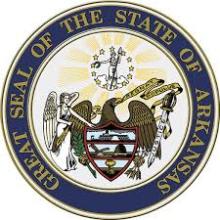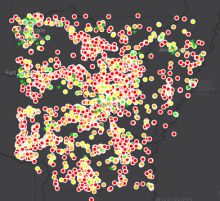
A host of cities and counties in Arkansas are about to get a major broadband boost thanks to local officials taking steps to act on a grant program deployed by the state last year. Borne out of the state’s 2020 1st Extraordinary Session at the end of March 2020 in response to the Covid 19 pandemic, the new Rural Broadband I.D. Expenses Trust Fund Grant Program will disburse $2 million in funds divided into 30 one-time grants of $75,000 each to towns, cities, and counties to tackle the digital divide in the Toothpick State. The program is financed via Arkansas’ Restricted Reserve Fund with money given to the state by the CARES Act, and is administered by the University of Arkansas for Medical Sciences (UAMS) Institute for Digital Health & Innovation. And while an array of projects have been awarded funds, money remains available and applications are being accepted on a rolling basis for those who have yet to take advantage.
A Win for Local Self-Reliance and Increasing Competition
The program is expressly designed to bridge the gap for communities that want to begin to improve local Internet access but are stymied by a necessary first step: paying for those economic, design, and feasibility analyses which require pulling together the wide range of options available in the context of local conditions. That’s where this program comes in, according to Rachel Ott, the UAMS Institute’s for Digital Health and Innovation Grant Director. Communities can use the work produced to apply for federal grants down the road, including the recently concluded Rural Digital Opportunity Fund (RDOF), the U.S. Department of Agriculture’s ReConnect Program, funds from the Agriculture Improvement Act of 2018, and any other forthcoming federal funding programs.
Cities, towns, counties, and unincorporated communities are all eligible to apply. Non-profits and for-profit entities are also eligible to apply, but only in unincorporated communities. If they want to undertake projects in cities or towns, they are required to partner with local governments.
“Generally, local entities do not budget for or have funds available for broadband due-diligence business studies in connection with making application for federal grants or loans for broadband development programs,” the General Assembly wrote last spring. “In order to spur further development of broadband in rural Arkansas . . . it is necessary to provide funds to local entities to further widespread broadband deployment, particularly in unserved and underserved rural Arkansas.” Eligible undertakings include:
- Full feasibility determinations, including economic business plans;
- Twenty-year financial break-even analysis;
- Competitive broadband analysis;
- Demographic analysis, with comparison to other projects;
- The ordering of construction plans to maximize return; and
- Analysis of federal funding opportunities
One of the boons of this program is how flexibly the funds can be used, including everything from forming broadband task forces and committees, to conducting surveys, to consulting with local utilities and electric cooperatives, to public education campaigns, to performing due diligence internally as preparation.
In addition and unlike many other grant programs, communities across Arkansas that already have access to 25/3 Megabit per second (Mbps) connections can also apply - a tacit acknowledgement that, in 2021, these speeds falls short. Communities can also use the funds to challenge existing mapping if they believe broadband in their community is not accurately reflected by the FCC’s Form 477 data, which notoriously overstates coverage from Internet Service Providers (ISPs). Even communities that had already gotten earlier federal funds are eligible.
A full list of winners hasn’t been announced, but in November the city of Benton got a $40,000 grant, and Arkansas, Howard and Polk counties were each awarded $75,000.
In December, the cities of Sherwood, Tull and Ward, Little River and Perry counties, the Eagle Ridge Property Owners Association in Pulaski County, and Kick Start Sheridan (a group representing development and future planning for the city of Sheridan, the Sheridan School District, and Grant County) all won grants for projects ranging from bringing services to unconnected households to full Fiber-to-the-Home (FTTH) partnerships with local ISPs and electric cooperatives. In fact, that’s been the norm for the grant program thus far, Rachel Ott said in an interview. Most of the recipients have been municipalities partnering with local companies and local electric cooperatives to improve access int the area.
“Without good broadband, Sherwood cannot reasonably grow. In essence, we are cut off from the rest of the state/world,” said Sherwood City Council member Beverly Williams of the pressing need, according to Arkansas Online.
The program was spearheaded by District 18 State Senator Missy Irvin. The University of Arkansas for Medical Sciences (UAMS) Institute for Digital Health & Innovation was chosen to administer the program based on its history with telehealth and rural broadband going back more than ten years.

Iterative Community Benefits
From the date of award, groups have six months to complete work and report results back to the Institute for Digital Health and Innovation, but successful communities can also look forward to additional funds. The way the legislation is written, up to $200,000 is available from the state for projects that have received federal funding as a result of the grant program to go towards the additional “expenses of obtaining a letter of credit, a bankruptcy opinion, or eligible telecommunications carrier application expenses, as required by the federal grant or loan awarded” through June 2021.
There are other benefits to the program in addition to directly improving Internet access. For instance, the results of any data work will be shared with the Arkansas Geographic Information Systems Office to provide mapping information to the Arkansas Spatial Data Infrastructure initiative. In addition, the grant website for communities considering applying has pulled together a welcome collection of resources to help communities no matter what stage of the process they are at, from a list of consulting, design, and financing partners to mapping to grant writing tips. The resource guide includes a wealth of information on broadband and digital inclusion, economic development, improving connectivity on tribal lands, and partnerships of all flavors, and will boost local efforts on broadband across the state from here out.
Recent Moves in Arkansas
The state’s broadband office map shows that the average connection speed for Arkansans sits at 27/9 Mbps. 22% of the state is stuck on DSL, 10% on satellite, and 14% is relegated to mobile devices. Just 3.3% is served by fiber connections, while much of the rest of the state struggles with download speeds of less than 20 Mbps (the orange and red dots in the map above).
The Rural Broadband I.D. Expenses Trust Fund Grant Program isn’t the only action the state is taking to remedy the situation: in response to Covid 19, the Arkansas Rural Connect Program funded 60 projects totaling almost $87 million last year, local electric cooperative OzarksGo passed a major milestone when it connected its 20,000th subscriber in November, and the city of Clarksville has begun hooking up the first homes to its new municipal fiber network.








